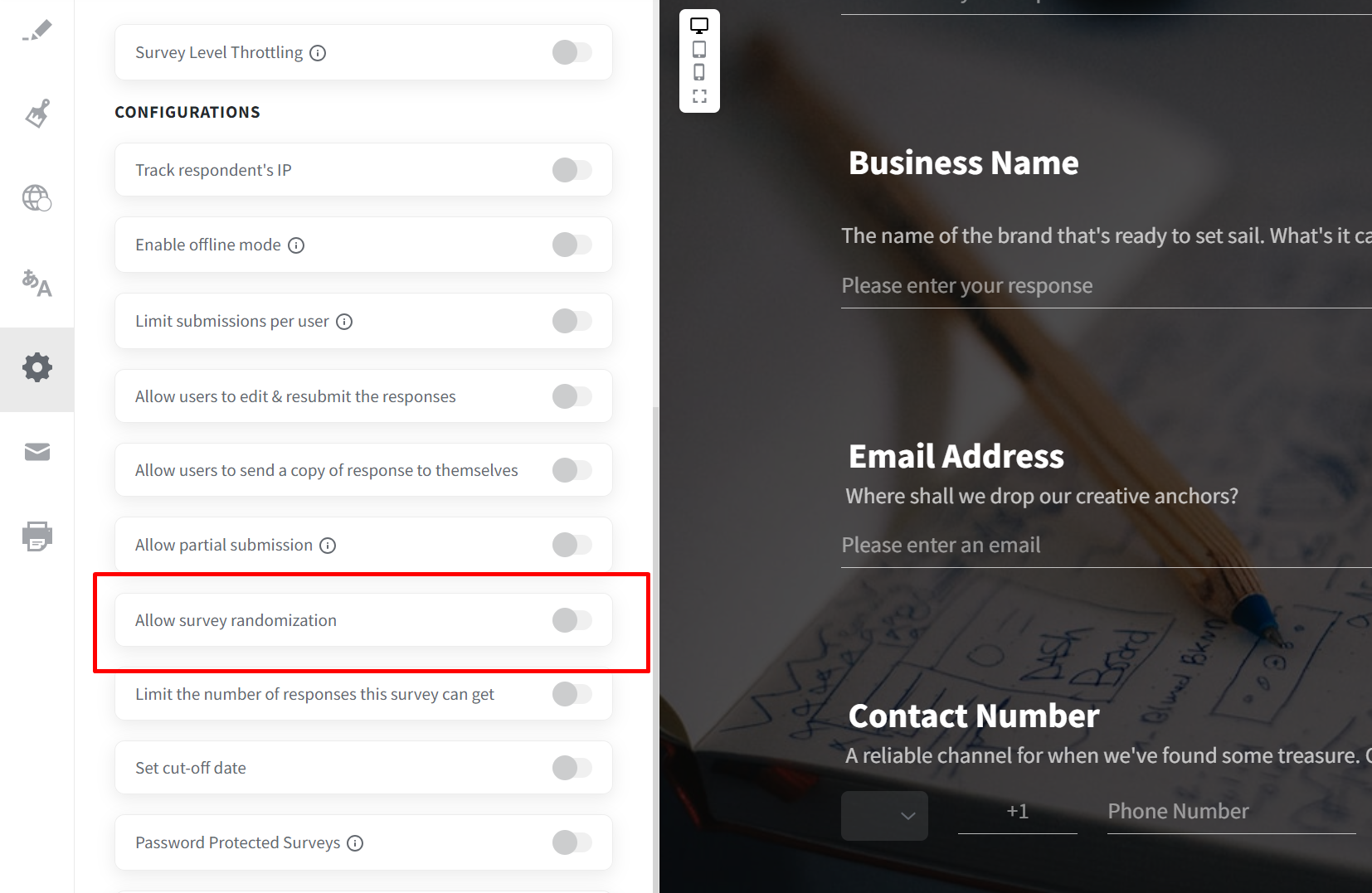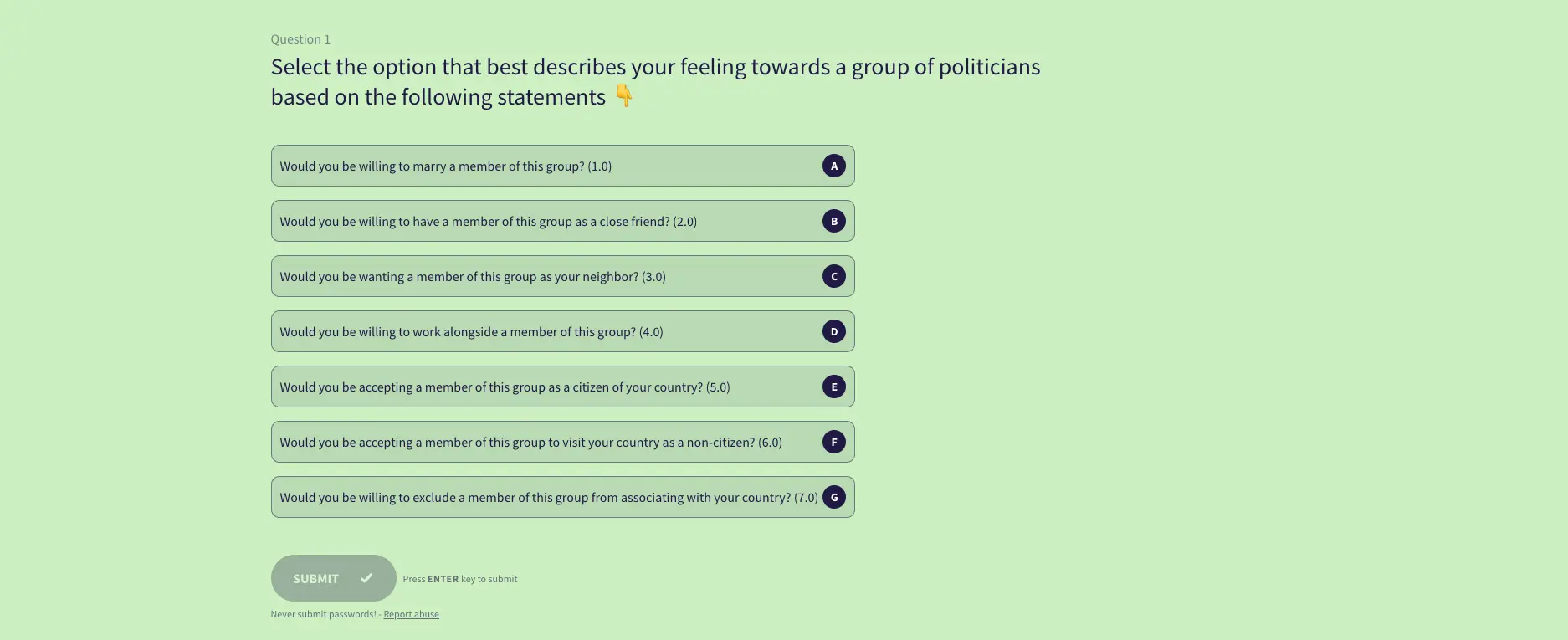Survey & Feedback
How Can Question Randomization Improve Your Surveys?
Article written by Kate Williams
Content Marketer at SurveySparrow
9 min read
19 September 2025

Did you know that the way you structure your survey questions can significantly impact the quality of data you collect? It’s a fact: the order in which you present questions can influence how people respond. What is your biggest concern when you conduct a survey or create a form? Well, for us, it is undeniably the difficulty in getting unbiased responses.But fear not, because there’s a game-changing solution: question randomization.
So, what exactly is question randomization, and why is it crucial for your surveys?
What Is Question Randomization?
You must be wondering “what does it mean for a question to be randomized?” Right? Question randomization is like an equalizer. Imagine conducting a survey where every participant encounters the same set of questions in the exact same order. Sounds like a recipe for bias, right?
Well, that’s where question randomization steps in. At its core, question randomization is the art of shuffling the order of questions for each respondent. It ensures that no two participants face the same sequence of questions, thus eliminating potential biases that could creep in if the question order remained static.
So, how does it work? When a survey employs question randomization, it means that the placement of questions is not set in stone. Instead, it varies from respondent to respondent. This simple yet powerful technique levels the playing field, making sure that every participant receives a unique questionnaire.
It’s not that hard when you have advanced tools to help you. For instance, if you use SurveySparrow to create your surveys, all you need to do is click on the “Allow Survey Randomization” option. Its as simple as that. Here’s how:

The key goal here is to break any potential patterns or influences that could affect the way participants respond. By doing so, we obtain data that is as genuine and uninfluenced as possible. In essence, question randomization offers a personalized survey experience, where each respondent’s viewpoint is allowed to shine through without external interference.
14-day free trial • Cancel Anytime • No Credit Card Required • No Strings Attached
Why Is Question Randomization Required?
The need for question randomization arises from a basic aspect of human behavior: the tendency to be influenced by context and order. Imagine this scenario: you’re conducting a survey, and you place a series of satisfaction-related questions immediately after a negative one. As a result, respondents might be more critical in their responses due to the preceding negative context. This can lead to skewed data and inaccurate conclusions.
Question randomization steps in to maintain objectivity. Its primary purpose is to ensure that every respondent faces a unique sequence of questions, free from any predetermined order effects. But why is this so crucial?
Importance of Question Randomization
Question randomization is pivotal in survey design. Here’s why:
1. Bias Elimination
Sometimes, surveys can be tricky. They ask questions in a certain order that can make people give the wrong answers. Question randomization stops this from happening. It mixes up the order of questions for everyone, so nobody gets tricked into answering a certain way.
When questions are presented in a fixed order, respondents may be influenced by the context or preceding questions. Question randomization disrupts this pattern, ensuring that each respondent faces a unique sequence of questions. This, in turn, reduces the risk of systematic bias, resulting in more accurate data.
Read more on Sampling Bias here.
2. Data Reliability
The reliability of survey data is non-negotiable. Decision-makers rely on survey results to make informed choices, and any hint of bias can lead to misguided decisions.
Imagine you’re a decision-maker, and you use survey results to make choices. If the data is biased, your decisions might be wrong. Question randomization ensures that the data you get is honest and true. This honesty is super important for making good decisions.
3. Enhanced Survey Engagement
Imagine taking a survey that feels repetitive and biased, where the order of questions seems to influence your responses. Such surveys are less likely to engage participants effectively. Question randomization changes the game.
When surveys are fair, people are more likely to take part in them. They don’t feel like the it is trying to trick them, so they answer more honestly. This means you get better feedback and more people completing the survey.
Create conversational forms to hasten the process!
4. Objective Insights
Question randomization helps you collect real opinions. When surveys are unfair, people might be influenced by the order of questions. With randomization, their answers are more about what they really think, not what the survey makes them think.
How Is Randomization Used in Sampling Surveys?
Imagine you want to find out what a big group of people thinks about a topic or product. Asking every single person in that group isn’t practical, so you choose a smaller group, known as a sample, to represent the whole bunch. But here’s the tricky part: you want your sample to truly reflect the big group. That’s where randomization plays a vital role.
1. Fair Selection
Randomization ensures that everyone in the larger group has an equal chance of being part of the sample. It’s like giving each person a fair lottery ticket. This way, your sample isn’t biased and stands a better chance of representing the larger group accurately.
2. Avoiding Biases
Imagine you’re researching people’s opinions about a new product. If you only ask those who have already bought it, you’ll get a skewed view. Randomization mixes things up. It might select some buyers and some non-buyers, giving you a more balanced perspective.
3. Better Predictions
When you use randomization, your sample becomes a mini-version of the big group. This means the insights and data you collect from your sample can be used to make educated guesses about the entire population. It’s like having a small but reliable crystal ball to predict what the majority of people are thinking or doing.
4. Representativeness
Randomization ensures that your sample represents the larger group as closely as possible. It’s like creating a mini-version of the big group. For example, if you’re studying a city’s population, randomization helps you select a sample that mirrors the city’s diversity in terms of age, gender, and other characteristics.
5. Minimizing Human Bias
People can sometimes introduce their own biases when selecting a sample. They might unintentionally pick people who are more convenient or familiar to them. Randomization takes the human element out of the equation. It makes the process objective and impartial, ensuring that the sample is selected purely by chance.
6. Statistical Power
Randomization allows you to use statistical techniques with confidence. When you have a random sample, you can apply mathematical formulas to make predictions about the larger group. This is incredibly valuable for drawing conclusions that are not just based on guesswork but grounded in data-driven insights.
7. Fairness and Ethical Considerations
Randomization is also essential from an ethical standpoint. It ensures that everyone in the larger group has an equal chance to participate in the survey. This fairness is crucial in research and surveys, as it respects the rights of every individual and avoids discrimination.
Types of Question Randomization
You have a few options to choose from, depending on your survey’s goals and structure. Here are the main types:
1. Complete Randomization
Imagine you have a deck of cards, and you shuffle them thoroughly every time you play. Complete randomization is a bit like that. With this method, you shuffle all the questions in your survey every time a participant takes it. It ensures maximum variability and unpredictability in the order of questions.
Use Case: It is handy when you want to eliminate any trace of order effects completely. It’s ideal for surveys where the order of questions doesn’t matter at all.
2. Block Randomization
Block randomization adds a touch of structure to the randomness. Instead of shuffling all the questions, you group them into blocks or sections. Each block gets randomized independently. This maintains some order while reducing the risk of order effects within each block.
Use Case: It is useful when you have sections of related questions in your survey. For example, in a customer feedback survey, you might have a block of questions about product satisfaction and another about customer service. Block randomization ensures fairness within these sections.
3. Page Randomization (Online Surveys)
In online surveys, questions are often presented on different pages. Page randomization allows you to shuffle questions within each page independently. This adds an extra layer of randomness, as participants encounter questions on different pages in varying orders.
Use Case: It is beneficial for online surveys where questions are grouped by topics on separate pages. It maintains fairness and unpredictability while ensuring participants don’t see the same page order.
Conclusion
Question randomization is the secret ingredient for achieving trustworthy survey results. By embracing this technique, you ensure that every response you receive is genuine and uninfluenced by the order of questions. It’s the key to unlocking unbiased data, making informed decisions, and enhancing survey engagement.
Ready to take your surveys to the next level? Explore how SurveySparrow can seamlessly integrate question randomization into your survey design process.
Sign up today! It’s free to try.
14-day free trial • Cancel Anytime • No Credit Card Required • No Strings Attached

Create engaging surveys that people actually complete. Try SurveySparrow now!
Kate Williams
Related Articles

Survey & Feedback
Bogardus Social Distance Scale: Definition, Survey Questions with Examples
11 MINUTES
28 April 2022

Survey & Feedback
Leveraging AI in Survey Analysis: A Guide for Businesses
10 MINUTES
16 August 2023

Survey & Feedback
Data Collection in Research : All You Need to Know
10 MINUTES
17 February 2023

Survey & Feedback
10 Smart Hacks to Increase Survey Response Rate
15 MINUTES
23 February 2018
